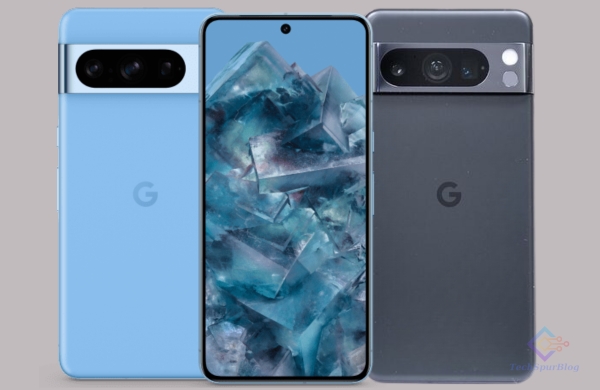
In the ever-evolving landscape of smartphone technology, Google’s Pixel series has consistently stood out for its stock Android software experience, powerful cameras, and AI-based features. With the release of the Google Pixel 8 Pro in 2023, the tech giant aims to redefine the flagship smartphone experience once again. This article will delve into the new features and improvements that make the Pixel 8 Pro a noteworthy addition to the Pixel lineup, including its flat Super Actua Display, enhanced chipset, extended software support, and revamped camera system.
Design and Display
The most noticeable change in the Pixel 8 Pro is its flat display, a departure from the curved screens of previous models. This design choice offers advantages, such as increased resistance to accidental touches. The phone maintains the aluminum frame and glass back characteristic of its predecessor, with a glossy visor-like camera bump. The Pro model features a matte back and glossy frame, a reversal of the standard Pixel 8’s design. The phone boasts Gorilla Glass Victus 2 for durability and is rated IP68 for dust and water resistance.
The Super Actua Display, a 6.7-inch LTPO OLED with a 120Hz refresh rate and a pixel density of 489 PPI, is a highlight of the Pixel 8 Pro. It offers vibrant colors, HDR 10+ support, and exceptional brightness, reaching up to 1,600 nits in auto mode. The adaptive refresh rate optimizes energy consumption, providing a smooth 120Hz experience during interaction and conserving energy by dialing down to 1Hz when idle.
Also Read: Google Pixel 8 Series: Leaks Reveal Storage, Colors, and Features
Audio and Biometrics
The Pixel 8 Pro is equipped with stereo speakers that deliver good loudness and well-balanced sound quality. It also features an under-display fingerprint reader that is faster and more accurate than its predecessor. The device offers ample storage options, ranging from 128GB to a whopping 1TB, though storage is not expandable via microSD.
Software and AI Features
The Pixel 8 Pro is among the first smartphones to come preloaded with Android 14, providing the pure Android experience as intended by Google. While the cosmetic changes are subtle, Android 14 brings new features, including a customizable lock screen, the ability to create unique wallpapers, and options for regional language, measurement systems, and date formats. It also supports 10-bit HDR images and lossless audio with wired headphones.
The device boasts AI-based features unique to the Pixel series. The Live Translate feature can rapidly translate conversations in real-time, while the improved Call Screening feature offers enhanced call management. Additionally, it can extract text from apps and images. A novel feature of the Pixel 8 Pro is its thermometer, enabled by a temperature sensor near the cameras, though its accuracy may need further development. Google also promises seven years of OS and security updates, surpassing most other manufacturers.
Performance and Chipset
The Pixel 8 Pro is powered by Google’s 4-nanometer Tensor G3 chipset, the same as the standard Pixel 8. Compared to the previous Tensor chip, the G3 features a new graphics processor, ISP, and TPU for AI tasks. In benchmark tests, the Pixel 8 Pro outperforms its predecessor in both CPU and graphics tasks, although it falls behind competitors running on a Snapdragon HN2. While the device offers sufficient power for everyday use, it may not be the top choice for heavy gaming due to its thermal management limitations.
Also Read: Why the Google Pixelbook 12in Should be Your Next Device
Battery Life and Charging
The phone is equipped with a 5,500mAh battery, providing satisfactory battery life but falling short of some competitors. It supports wireless charging and fast charging, with a 30W charger taking around 1 hour and 23 minutes for a full charge.
Camera System
The Pixel 8 Pro’s camera system is a standout feature, offering a 50MP main camera, a 48MP 5x telephoto zoom, and a 48MP ultra-wide camera. The main camera captures excellent photos with abundant detail and pleasant rendition. In low-light conditions, night mode processing enhances photo quality. The device allows high-resolution 50MP photos for those seeking additional detail.
The 5x telephoto zoom captures sharp, detailed shots even in low-light conditions with the aid of night mode. It excels in video recording, offering impressive detail, dynamic range, and color saturation. The ultra-wide camera has a sharpness that extends to the corners and provides good results in low-light conditions, outperforming its counterpart in the standard model.
Selfies, taken with the 10.5MP front-facing camera with autofocus, offer good detail and pleasing skin tones.
Also Read: Google Pixel Watch 2: Review of the Ultimate Wireless Wearable
Conclusion
Google Pixel 8 Pro brings a host of improvements over its predecessor, with its flat Super Actua Display, enhanced chipset, and revamped camera system. The promise of seven years of software support is a significant advantage. However, it falls behind competitors in terms of battery life and thermal management, making it a top choice for photography enthusiasts and Android purists, but not necessarily for hardcore gamers.
The Pixel 8 Pro stands as Google’s flagship for 2023, and its feature-packed design and advanced capabilities ensure it is a device worth considering for those in search of a premium Android smartphone experience.

Leave a Reply